Ciambelline Biscotti (Ring Cookies)
Ciambelline (chahm-bel-LEEN-ay), plural, ciambellina, singular, is one of those Italian words that has various translations, both edible and not. Some dictionaries translate it (edible) as “donut,” others as “bagel,” and a few as “Bundt cake.” For the not so edible, it can be translated as “inner tube” or “life ring.” In general, you get the idea that it is a circular object.
When I lived in Viterbo, Nonna taught me how to make these ring-shaped biscotti (cookies) with white wine, though in the photo above I used a red. You can also make them with prosecco, spumanti, or even Sambuca, for an anise-flavored cookie. I often ate them as a mid-afternoon snack before going into the den for my language lesson with Alessandra (the details of my stay with this Italian family are the basis of my book, Beyond the Pasta).
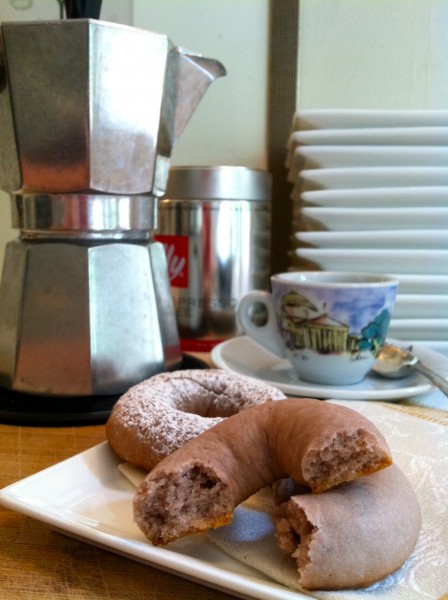 Typically, ciambelline are served with a glass of wine or with an after-dinner digestivo such as grappa, vin santo or moscato d’asti. However, you can often have them in the morning with a cappuccino or caffè.
Typically, ciambelline are served with a glass of wine or with an after-dinner digestivo such as grappa, vin santo or moscato d’asti. However, you can often have them in the morning with a cappuccino or caffè.
Either way, these ring cookies are meant to be dunked into something. Made without any leavening agent or eggs, which is how they are made in the region of Lazio, ciambelline are rather dry and firm—truly a biscotti and literally not a cookie, so dunking is preferred, if not essential.
I have found that ciambelline can be finished with a couple of different toppings: granulated sugar, powdered sugar or simply plain, which is how Nonna made hers. Those topped with sugar seemed to be served more with coffee, while the plain seem better suited for wine.
There is a larger, truly “donut” version—Ciambelline di Patate, which are made with potatoes/flour, fried and rolled in a granulated sugar/cinnamon mixture—usually made for holiday celebrations like Christmas or Carnivale in February.
In true Italian dessert fashion, ciambelline biscotti are not an overly sweet treat, so don’t expect an American “cookie” when you make these. Cookies for us usually get dunked into coffee or milk, we have no “dunk a cookie into wine” tradition here, so we naturally associate cookies with SWEET and chewy. For an Italian, these are sweet and the “chewy” is achieved in the dunk.
I hope you’ll make a batch of these and give them a whirl. I know these were a “life saver” of a treat for me before my afternoon language lessons—so, if nothing else, it could give you an excuse to have a glass of wine as a mid-afternoon spuntino—snack. Sometimes a life saver, indeed!
Buon Appetito~
Mark
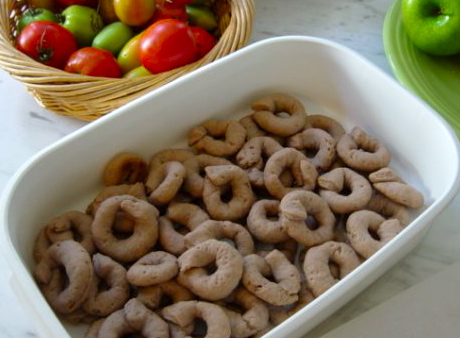
Ciambelline al Vino
Ring Cookies made with Wine
3/4 cup sugar
3/4 cup white or red wine (I prefer a Chianti for red; a Pinot Grigio for white)
1/2 cup sunflower oil (vegetable oil may be substituted)
1/4 cup extra virgin olive oil
1/8 teaspoon salt
4 cups all-purpose flour, plus more for kneading
[*NOTE: This is for plain ciambelline. For granulated sugar coated: before baking, take the formed ciambelline and press the “top” of the ring into granulated sugar and place the non-sugared bottom on the parchment baking sheet. For powdered sugar coated: Make the “plain” recipe and, after being baked and cooled on the rack, dust the tops of the ciambelline with powdered sugar.]
Preheat oven to 350 degrees. Line a baking sheet with parchment paper.
In a medium bowl, mix together sugar, wine, oils and salt, stirring until well combined. Stir in one cup of flour at a time, mixing well between each addition, until a soft pasta (dough) is formed.
Turn the pasta out onto a lightly floured surface and knead for 5 minutes (adding a little additional flour if the pasta is too sticky) until smooth. Break off a golf ball-size piece of the pasta and cover the remaining with plastic wrap to keep moist.
Place the piece of pasta on the board and, using both hands, gently roll the dough into a cigar-shape. Continue rolling your hands back and forth, and while rolling from the center out to the ends, spread you fingers apart to lightly stretch the dough into a longer and thinner piece. (This is the same process used to shape gnocchi.)
Continue rolling until the dough is between the diameter of a pencil and the thickness of your little finger. Cut into 3 ½-inch to 4-inch long pieces. Take each piece and make a small ring by overlapping the two ends and pushing the top end into the bottom end to seal. Place on the parchment lined baking sheet. [See *NOTE above for sugar coated ciambelline.] Continue the process by breaking off another golf ball-size piece of pasta, rolling into a cigar-shape, etc.
Bake for 12 to 14 minutes until the bottoms are golden brown and the tops are just firm. Remove ciambelline to a wire rack to cool.
Makes about 96 small rings (traditional Nonna-sized) or about 24 larger rings (made as I do, with the rolled ropes being the thickness of your index finger and cut into 9-inch lengths, baked for about 16 to 18 minutes). Nonna would say mine are “Troppo grande”—“Too big!”
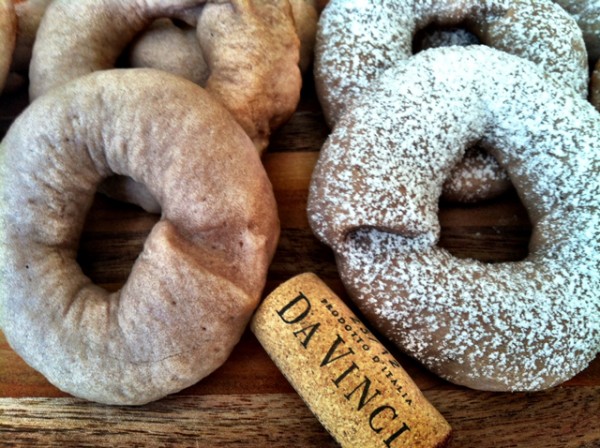
To give you an idea about size, Nonna’s would be as round (outside edge) as a wine cork is long, while mine (pictured here) are almost twice that size.
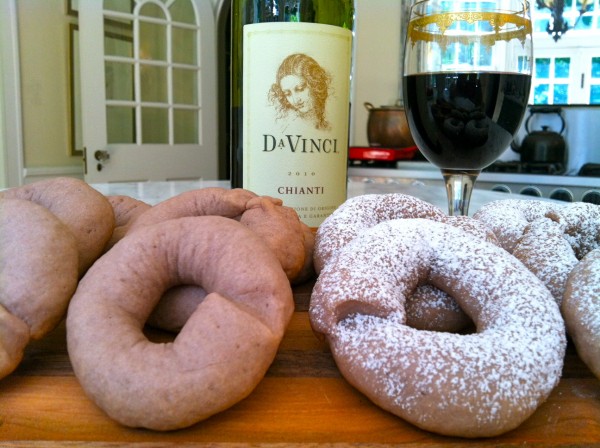
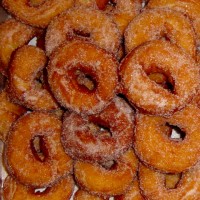
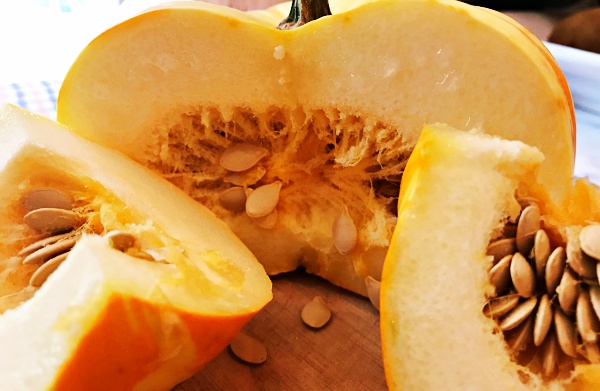

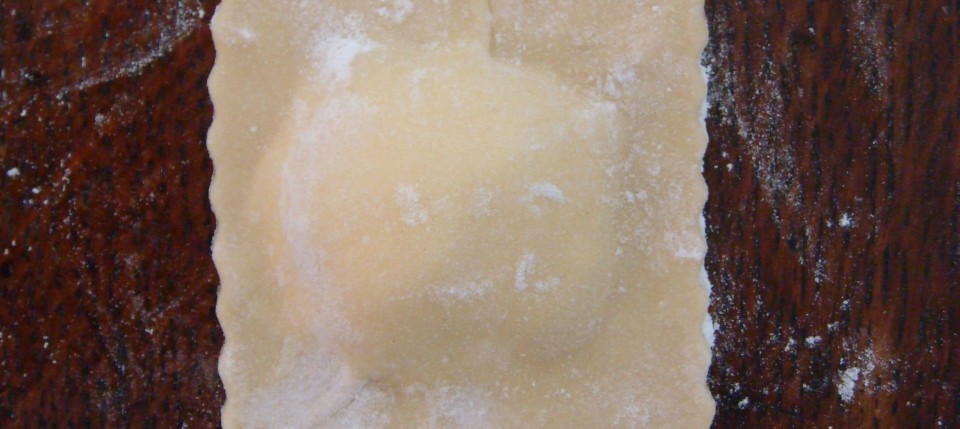





I have been looking for a while for a recipe in English that I could share with my friends. Great blog, and this recipe is spot on! The first time I had these cookies was in Viterbo many years ago. The white wine ones are great, but the red wine version is my favorite!